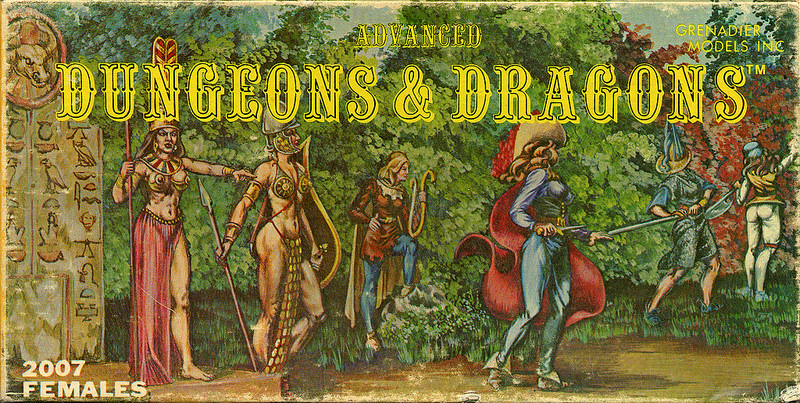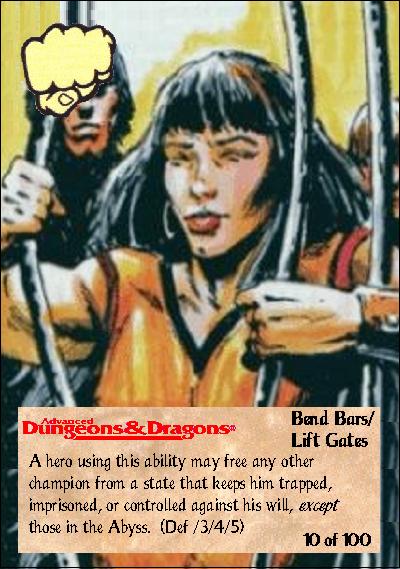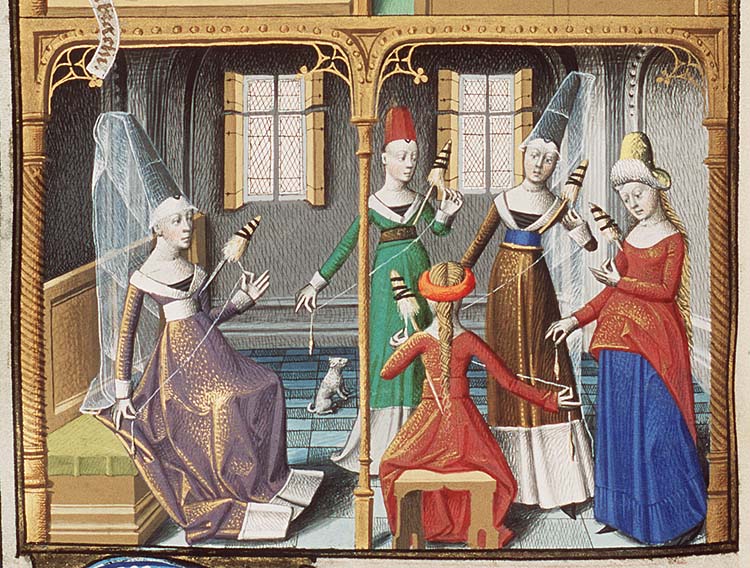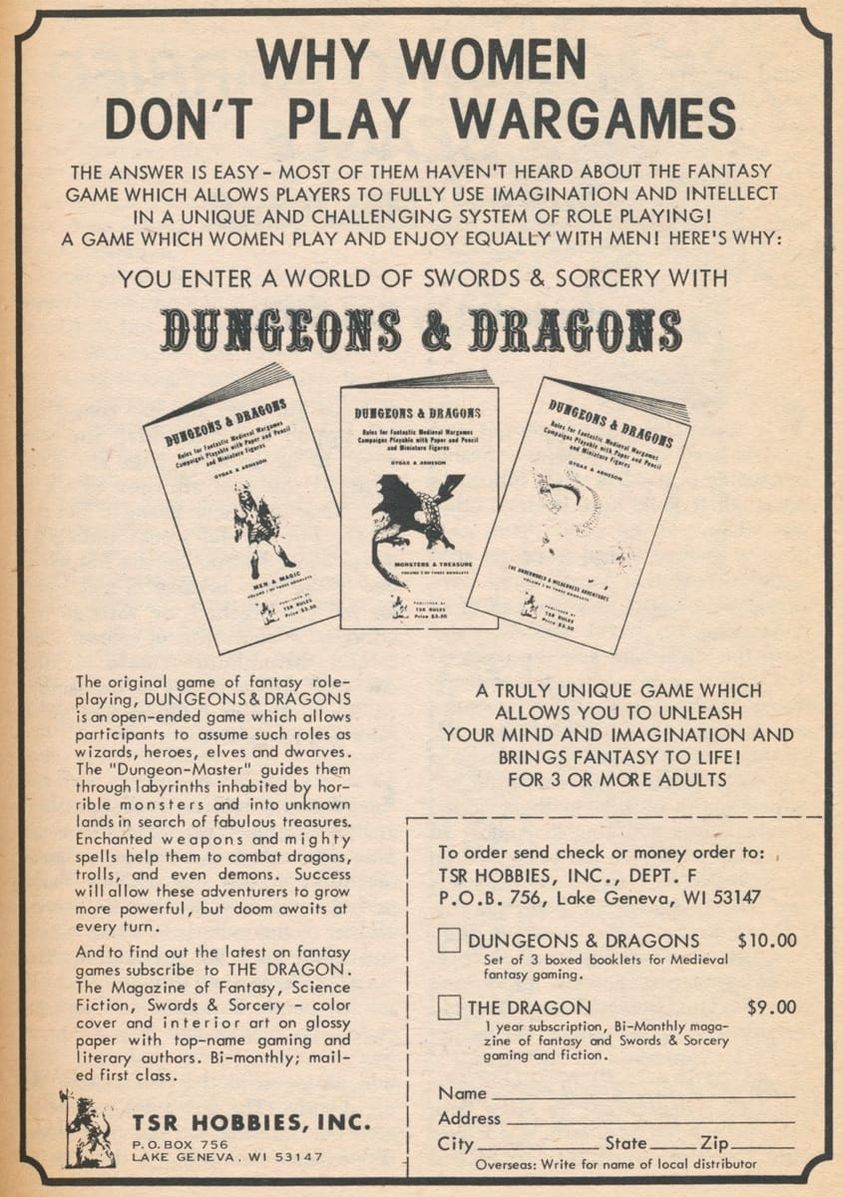| The Anti-Paladin | Women Want Equality | Women: Points to Ponder | Bows | Critical Hits |
| Uniformity, Conformity, or Neither? | IDDC II | FN: Work in Progress | UOAS: Morality in Fantasy | LTH: Starting From Scratch |
| GITE: Bodvar Bjarki, Egil Skallagrimson | Bazaar of the Bizarre:
Cloud Castles
|
Groundsquid | 3d6 Odds | - |
| Next Time, Try a Cleric | BOTB: Greenstone Amulet | BOTB: Mist of Rapture | BoTB: Laeral's Storm Armor | BotB: Horn of Cornucopia |
| BotB: Candle of Methven | BotB: Keys of Sirdan | BotB: Larmacian Holy Symbol | BotB: Mail of Red Dragon Scales | Dragon magazine |
Putting the two Dragon 39 articles together:
A) raise female human Str.
limit to 18/75
B) +1 Constitution for all
females
C) '+1' Wisdom (only for purposes
of magical defense adjustment) for all females
D) +1 Dexterity for female
fighters
Women Want Equality.
And Why Not?
by Jean Wells and Kim Mohan
Dragon 39.16


As other minorities have done throughout history, female play-
ers of D&D, AD&D and other role-playing
games are finding it
necessary to cope with discrimination and prejudice as they seek the
satisfaction and fulfillment they are entitled to receive from playing
a
role in an adventure game.
Some of the obstacles set in front of women players by the
structure of the D&D game system itself, as well as those barriers
posed by male players with personal prejudices against women, will
weaken or disappear with the passage of time. In fact, many aspects
which women players have had reason to be upset about in the past
have improved. But it is also apparent, from letters sent by women
players around the country as contributions to this article, that many
instances of unfair and degrading treatment of women players—and
their characters-remain to be corrected.

In some circles of players, women are looked upon as “maver-
icks” when they try to join in the enjoyment of a campaign along with
men. Why? Is it because these women enjoy using their imagina-
tions, being creative and expressing themselves through their char-
acters? If so, then male players rightfully deserve to be described
in
the same way. Role-playing games are rising in popularity all the
time, but even so, the total number of players of both sexes is still
a
very small fraction of the entire population.

Are women “mavericks” because they only comprise roughly
10% of all D&D or AD&D players? If so, the description is unfair
because women have not always been afforded the same opportuni-
ties to become exposed to the game. For example, the Original
edition of D&D stemmed from Chainmail, a set of rules for use with
fantasy miniatures. Chainmail is, by a general definition of the word,
a “wargame,”and women have never, as a group, been inclined
towards those kinds of activities. Most female gamers (or potential
gamers) can well appreciate the skill and enjoyment involved in
moving figures around on ‘a tabletop, but do not enjoy doing it
themselves.

A related cause for women’s lack of exposure to the game is the
fact that, until quite recently, generally the only places D&D,
AD&D
and other such games could be found was in hobby shops and
specialty stores of that general type. Other merchandise in hobby
shops includes model railroading suppies, ship and automobile
models, and wargames (as opposed to role-playing adventure
games). None of those other products have been traditionally con-
sidered attractive to women. It is a safe assumption that, even in
this
day and age, most women who enter a hobby shop are there to buy
something as a gift instead of for their personal use. There is a chance
that a woman will see something that interests her personally, such
as a D&D game or the AD&D books-and that’s how many females
find out about role-playing. More women are entering the ranks of
players and DMs all the time, but D&D and AD&D remain primarily
men’s games, and most women who learn about the games are
introduced to role-playing by their male friends.
Just as in real life, women have a different outlook on, and
perhaps a different approach to, “life” in a fantasy campaign. Wom-
en who play female characters must be concerned about their char-
acters becoming pregnant, or about their characters being “used” as
sex objects to further the ends of a male-dominated party of adven-
turers.
One reader, Sharon Anne Fortier, related a story about a female
dwarf character of hers that was forced by the males in the party to
seduce a small band of dwarves so the party could get the drop on
them and kill them.
Another reader wrote of being penalized by her DM because she
was a Cleric and had the misfortune (as it turned out) to become
pregnant. The DM said that Lawful Good Clerics didn’t do that sort
of thing, he forced the character to undergo a change of alignment,
and the player eventually had to roll up a new character.
The other side of this coin is that female players do enjoy having
their characters flirt with male player characters and NPCs, showing
a personality they might be too shy or too afraid to display in real
life.
One reader pointed out that playing a female character allows her to
do things she thinks would be fun, but would never try to do in real
life—like wearing a low-cut dress and bending down to brush some
dirt off her ankle while watching the reactions of the men around her.
16
Some DMs find it difficult or do not choose to moderate these
types of encounters. But those who can and do discover that such
episodes broaden the scope of their game beyond the level of a
“Let’s go kill some monsters” kind of campaign. There is great
potential for more than hacking and slashing in D&D or AD&D;
there is the possibility of intrigue, mystery and romance involving
both sexes, to the benefit of all characters in a campaign.
Naturally, women players (acting through their characters) will
generally want to venture into a dungeon or out into the wilderness
on dangerous adventures. But there will be, and should be, times
when women want to pursue other particular aspects of their char-
acters’ natures. The game offers many opportunities for players to
try their hand at problem-solving without actually being involved in
combat against monsters. Many of the female players who contribu-
ted information for this article indicated that the men they play with
aren’t all that interested in solving problems except by fighting;
they
get upset when a woman player wants to try to talk to a monster
instead of attacking it.
Laura Roslof said that the men she has been involved in gaming
with seem to expect females to wait obediently by the door while
they (the males) sort through the treasure. She said that wouldn’t
be
so bad by itself, but then the men usually refuse to provide females
with a fair share of the loot.
Judith Goetz seems to be one of the more fortunate female
players. She plays with family members and close friends, and said
she encounters very few obstacles because of her sex. She also said
that when she plays in tournaments, she does run into the “hack and
slash” type of player, but most of them are adolescent males. These
types of players not only aggravate her, but other, more mature male
players as well.
“Some of the ‘downs’ of D&D for me are in encountering men’s
collections of fantasy figures whose only females are the naked
sirens who serve only as so much booty—and, for that matter, the
cartoons run in The Dragon that present the same view.”
Many women are understandably appalled by the appearance of
female miniatures. They range from half-naked (possibly more than
half) slave girls in chains or placed across horses or dragons, to
women fighters dressed in no more than a bit of chainmail to protect
their modesty and perhaps a backpack and a sword. Or, there are
female Magic-Users wearing nothing but a smile and a bit of cloth
draped over one arm.
The attire of the figures does not reflect the reality of the game.
Female fighters wear just as much body protection as their male
counterparts. Female Magic-Users wear robes, carry backpacks and
have lots of pockets for material components, just like males do. But
such figures are few and far between on the shelves of stores.
Then there is the D&D or AD&D game system itself. Another
often-heard complaint from women concerns the built-in restrictions
on maximum strength for female player characters. It does seem
unfair to many women that human female characters cannot have
Strength of more than 18/50, when men can attain 18/00. However,
the reason for this is based in reality and cannot logically be argued
against. Women are, as a group, less muscular than men, and
although some women may indeed be stronger than some men (as
in real life), the strongest of men will always be more powerful than
the strongest of women.
An argument could be made, however, for raising the female
Strength maximum to 18/75, for instance, which would make the
“discrimination” less severe by at least affording women the chance
to attain a +2 Hit Probability to go with the +3 Damage Adjustment
that women of exceptional strength receive already for being be-
tween 18/01 and 18/50.
Many suggestions have been advanced for compensating wom-
en for the Strength limitation by giving them greater potential for
high scores in other ability areas (Editor’s note: Some of these
suggestions are outlined in the article which accompanies this one.
).
Until such time as an official rule change is enacted (which is not
to suggest that a change is in the works), women players and those
men who are concerned about women’s welfare will be left to devise
their own methods of strengthening female characters, if they think
that such strengthening is necessary.
As with any other variant incorporated into a campaign, the only
constantly important consideration is game balance. The D&D and
AD&D game systems were designed with playability in mind,
and
the designers must necessarily sacrifice “realism” at times to achieve
the playability and overall balance that the game needs to have, to
be of maximum benefit to the greatest number of players. Perhaps
changes do need to be made in the game structure, and perhaps they
will be—but no change for the sake of one improvement is worth the
damage it might cause to other aspects of the game. D&D and AD&D
are games, and they’re supposed to be fun — not just for men or for
women, but for everyone.
Points
to Ponder
by Kyle Gray
Dragon 39.17

As a female player of D&D, there is one thing
that never fails to annoy me: the underestimation of the abilities
of
female Fighters. At times I have found
it necessary to assume the role
of a male character because if I chose to be female, my strength
would be limited by the game rules, and thus my character would be
generally less effective than a male. There are no compensations to
the female for this limiting of strength, making it seem as though
women warriors are being discriminated against.
There are many literary and historical examples of female fight-
ers, the most well-known being the Amazons. The Aethiopia, an
ancient continuation of the Iliad, tells of Penthesilea, the beautiful
Amazon queen who stood up and fought Achilles, greatest of all the
Argive warriors. Also, when Theseus carried off the Amazon
Antiope, her sister, Oreithyia led an army of Amazon warriors into
Attica, and it took the entire Athenian army four months to defeat
them. And who could forget Camilla, the Volscian warrior maiden of
Virgil’s Aeneid? She killed many Trojans, fighting with both arrows
and battle-axe, and was easily one of the best warriors in the battle,
male or female.
The Greek and Roman mythos are not alone in containing
stories of women warriors. Brunhild and the Valkyries are major
elements in the Germanic sagas, and warriors in their own rights.
The Celts had their War Queens, and there are historical references
of those women fighting right alongside their male counterparts. In
fact, some sources say that the women were the most vicious and
warlike of all the Celtic warriors. Even Christianity, which is respon-
sible for most of the Western World myths of the inherent weak-
nesses of women, has Joan of Arc.
Heroic fantasy, the main influence of Dungeons & Dragons,
though dominated by male characters, has also produced its share of
female warriors. One of the earliest and the best of these is C. L.
Moore’s Jirel of Joiry, the fierce woman fighter who has no problems
competing with her male counterparts. Surprisingly, some of the
best female characters have emerged from the stories of male
authors writing in the best macho traditions. Edgar Rice Burroughs’
Deja Thoris, while too dependent on John Carter, is still an excellent
warrior, and there are many examples of women who, when forced
to defend themselves, are quite capable fighters.
Undoubtedly the best creator of female warriors was Robert E.
Howard. Known best for his Conan and Kull
tales, Howard also
created an impressive array of women warriors. Everyone’s favorite
Male Chauvinist Barbarian, Conan, meets his match in Valeria of the
Red Brotherhood, and serves under another female fighter, his
lover, Belit, a bloodthirsty pirate. Howard even wrote a series of
tales
about Dark Agnes, his Sword-Woman, who could outfight and
outdrink any man.
Probably the most famous of Howard’s women warriors, thanks
to Marvel Comics, is Red Sonja. Red Sonja of Rogantino, a red-
haired warrior, appeared in the Howard story “Shadow of the
Vulture,” which took place during the Crusades. Many years later
Roy Thomas, writer of Marvel’s Conan the Barbarian, used this story
as the basis for a Conan tale, and Red Sonja, warrior woman of
Hyrkania, was born. During her career, Sonja has outsmarted and
outfought Conan and many other men, and is undoubtedly the
epitome of a female warrior.
Recently, more and more women warriors have seen print, and
some, like Roland Green’s Gwyanna of his Wandor series, are quite
excellent. So, fellow female players, if you run into a MCDM (Male
Chauvinist Dungeon Master), get him to read some of the above
mentioned stories, and maybe he will agree that the women warriors
are discriminated against. The next step is to get him to follow the
guidelines below.
The Advanced D&D Players Handbook
only takes female attri-
butes into account for one ability, that of Strength. Females of all
the
character races are allowed a maximum Strength score which is
lower than the males’ maximum. Men tend to have a more massive
musculature, and for this reason can perform feats of brute strength
usually beyond the capabilities of women. This physical difference
is
taken into account, but other, more beneficial differences are ig-
nored. Women have smaller, less bulky muscles, and as such, are
generally more agile than men. Also, women are able to withstand
higher levels of mental and physical stress than the average male.
Given those facts, it is obvious that while it may be logical to penalize
women in terms of sheer strength, it is equally logical to reward them
for better Dexterity and hardier Constitution
It is a medical fact that the average female can withstand more
mental stress than the average male. Because of that, females in
D&D should be rewarded with a +1 in Wisdom for magical attack
adjustment only. This would give women a better chance to resist
mental attack forms involving will force, as described in the Players
Handbook.
Also, since women have smaller, more compact muscles, they
are less bulky than men, and are naturally more agile. Therefore
women warriors, who would logically be trained to take advantage
of this, should receive a + 1 on their roll for Dexterity.
It has also been shown that women are able to tolerate pain
better than men, and when raised under the same conditions, are
generally hardier. Women generally live longer than men, barring
disease or accidental death. For those reasons, female characters
should receive a +1 on their rolls for Constitution.
The above-mentioned adjustments should make up for the
lower maximum strength score for women. While they will still have
a relatively rougher time breaking down doors and bending bars,
women warriors will no longer be discriminated against. Men and
women are physically different, but this does not mean that women
are necessarily deficient when it comes to fighting. What it does
mean is that women, precisely because they are not as strong as
men, would use their natural abilities and adopt a different fighting
style, more “slash and run” than “stand and swing.” The +l in
Dexterity would merely reflect this
style, and should apply only to
female Fighters rather than female characters in general, because it
would be an extension of warrior training. Given this +1 in Dex-
terity, and also a +1 in Constitution and magical attack adjustment
that should apply to all women characters, women warriors in D&D
can now become formidable Fighters and compete on an equal basis
with the men.
"Money talks"
Dear Dragoneers
As a woman DM, I was very pleased to see your
articles in #39 about the role of women in fantasy
gaming, even though they were illustrated with the
usual cheesecake Since I’ve run across many a
macho type myself, I can sympathize with other
women who have problems with their male fellowgamers.
The problem of female fantasy-figures is a
particularly vexing one to me, as is the appearance
of naked and ridiculous female figures in much
fantasy-gaming advertising. Faced with this
problem, however, we women FRP’ers have a
powerful weapon indeed: money. I would like to
suggest to other women as annoyed as I am that
we start wielding this weapon If women do indeed
comprise about 10% of the gaming force,
that means we spend 10% of the cold cash for
FRP products. Ten per cent may not sound like
much, but in a time of economic recession, losing
10% of their business could mean disaster to
many small companies. If someone’s ad offends
you, write and tell them Calmly and rationally,
make it clear that you won’t spend one cent on
their products because of this offensive advertising.
The same goes for lines of figures. Here, of
course, all you need to do is point out that you
would indeed spend money for a decent figure. If
a line does produce some good female figures,
write and tell them you bought them. In our
society, money talks, but we have to give it a voice.
To use myself as an example, I’m a working
person whose main hobby is FRP This means that
not only do I have money to spend, but that I
spend a lot of it. In my area are several gaming
stores I no longer go to the one that treated me
rudely and that had boy’s club vibes This means I
spend my thirty bucks a crack in the other, more
liberated store. To a small retailer, a thirty-dollar
sale is big business If enough women start doing
the same — and telling the men about it —
changes may happen
The key is telling them. Bizarre as it seems to
many women, most men don’t realize how offensive
they’re being when they gloat over cheap
porn in the form of fantasy gaming aids The
macho conditioning is simply so strong as to be
blinding If you present the case calmly, they may
listen. If not, threaten to withdraw the money. If
nothing else, writing a few nasty letters is splendid
training in assertiveness, a skill that every FRP’er
needs.
The illustrations in many fantasy books and
magazines is also offensive to me and other
women (no, Dragon dear, you’re not immune
to
this charge,) but here I take a more bemused,
tolerant attitude. It is hard to call a picture ‘sexist’
when the men are as ridiculously attired as the
women. The cover of #38 is a swell
example, alas
While I’m not a simulation purist, there are limits
Gentlemen, please — no one goes to war in a
Speed-O bathing suit.
Katharine Brahtin Kerr
San Francisco, CA
(The Dragon #42)
Sorry about the artwork in #39. We had hoped
to illustrate the stories with perfectly appropriate
drawings — but as it turned out, 100-percent nonsexist
renditions of females are even harder to find
in our art files than in miniature-figure display
racks The drawings we did use (by Jamie Graham
and Jean Wells) didn’t precisely fit the tone of the
written matter, but it was decidedly the best, for
that purpose, among the rather small selection of
“women in art” that we’ve been sent. Artists, take
note.
As for the cover of #38, we prefer to think of it
as a portrait of Niall and Lylthia, rather than a
portrayal of them in the context of the story. If
artist John Barnes had shown us a Niall clothed in
fighting togs in a “posing” pose, would a “simulation
purist” not also have objected to that?
— Kim
(The Dragon #42)
"Horrified!"
Dear Editor:
Concerning the article entitled “Points to
Ponder” in #39: The history was impressive but
when the author began his list of bonuses for
female characters I was horrified! Consider his
suggestions: +1 on Wisdom for magical
attack,
+1 on Dexterity, +1 on Constitution. These adjustments
are supposed to be made in order to
“give the women an even break” since they cannot
have a Strength above 18/50 (an event which
should happen only once in more than 430 ability
rolls).
I believe that women characters already have
some advantages which their male counterparts
do not have — the ability to bear children not
being the least of these. As opposed to denying
the arguments of the author, I propose a different
scheme to make things fair. Simply limit the maximum
male Dexterity to 18/50. This can be
justified by the very points made in the article —
small, light muscles as opposed to large, heavy
ones.
Howard Cohen
Stockton, CA
(Dragon #42)
We have received many more letters in reaction
to our “women in D&D”
stories than we can ever
hope to have room to print. Howard’s letter is a
typical one, not in the specific criticism he puts
forth but in the fact that he thinks there’s a different
and better way to balance the female’s
Strength disadvantage with an advantage in some
other aspect of generation of abilities. There may
well be as many different ways of “balancing” a
campaign in this regard as there are campaigns —
and that’s fine. The point is that if you feel strongly
enough about the “unfairness” of the rules to
change them, you’re free to change them in any
way you want, within the context of the campaign
you’re playing in.
Kyle Gray’s article was not presented (or
written) as the definitive statement on “how to
help women characters”. It contained “points to
ponder,” and from the looks of our batch of letters
to the editor on the subject, a lot of you have done
a lot of pondering. Thanks for letting us know your
thoughts, even though we can’t print every letter.
Incidentally, we know Kyle would appreciate it
if we’d point out to Howard (and anyone else who
might be mistaken) that, like it says in the first line
of the article, she is a female player.
— Kim
(Dragon #42)